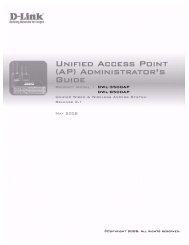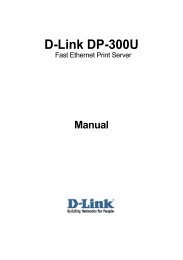Product Manual
Product Manual
Product Manual
Create successful ePaper yourself
Turn your PDF publications into a flip-book with our unique Google optimized e-Paper software.
DES-3526 / DES-3526DC Fast Ethernet Layer 2 Switch<br />
The DES-3526 supports IEEE 802.1Q VLANs and Port-Based VLANs. The port untagging function<br />
can be used to remove the 802.1Q tag from packet headers to maintain compatibility with devices that<br />
are tag-unaware.<br />
The Switch's default is to assign all ports to a single 802.1Q VLAN named "default."<br />
The "default" VLAN has a VID = 1.<br />
The member ports of Port-based VLANs may overlap, if desired.<br />
IEEE 802.1Q VLANs<br />
Some relevant terms:<br />
• Tagging - The act of putting 802.1Q VLAN information into the header of a<br />
packet.<br />
• Untagging - The act of stripping 802.1Q VLAN information out of the packet<br />
header.<br />
• Ingress port - A port on a switch where packets are flowing into the Switch and<br />
VLAN decisions must be made.<br />
• Egress port - A port on a switch where packets are flowing out of the Switch,<br />
either to another switch or to an end station, and tagging decisions must be<br />
made.<br />
IEEE 802.1Q (tagged) VLANs are implemented on the Switch. 802.1Q VLANs require tagging,<br />
which enables them to span the entire network (assuming all switches on the network are IEEE<br />
802.1Q-compliant).<br />
VLANs allow a network to be segmented in order to reduce the size of broadcast domains. All packets<br />
entering a VLAN will only be forwarded to the stations (over IEEE 802.1Q enabled switches) that are<br />
members of that VLAN, and this includes broadcast, multicast and unicast packets from unknown<br />
sources.<br />
VLANs can also provide a level of security to your network. IEEE 802.1Q VLANs will only deliver<br />
packets between stations that are members of the VLAN.<br />
Any port can be configured as either tagging or untagging. The untagging feature of IEEE 802.1Q<br />
VLANs allows VLANs to work with legacy switches that don't recognize VLAN tags in packet<br />
headers. The tagging feature allows VLANs to span multiple 802.1Q-compliant switches through a<br />
single physical connection and allows Spanning Tree to be enabled on all ports and work normally.<br />
The IEEE 802.1Q standard restricts the forwarding of untagged packets to the VLAN the receiving<br />
port is a member of.<br />
The main characteristics of IEEE 802.1Q are as follows:<br />
• Assigns packets to VLANs by filtering.<br />
• Assumes the presence of a single global spanning tree.<br />
• Uses an explicit tagging scheme with one-level tagging.<br />
• 802.1Q VLAN Packet Forwarding<br />
• Packet forwarding decisions are made based upon the following three types of rules:<br />
• Ingress rules - rules relevant to the classification of received frames belonging to a VLAN.<br />
• Forwarding rules between ports - decides whether to filter or forward the packet.<br />
• Egress rules - determines if the packet must be sent tagged or untagged.<br />
60

















